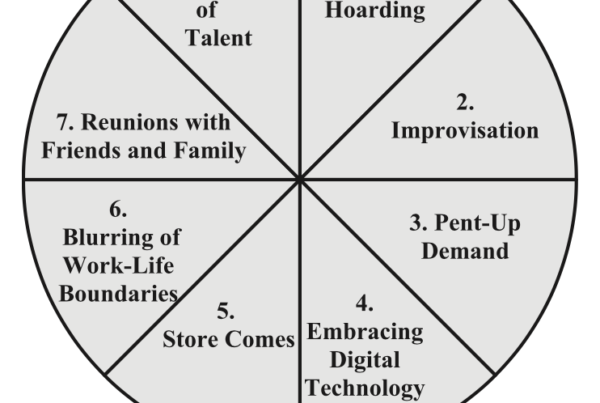Choice Model for Buyer Behavior, Research In Marketing, Supplement 1, pages 163-167
There is no question that the Triandis model of choice behavior is very relevant and useful in marketing and consumer behavior.
First, it is a more comprehensive model of choice behavior than most other models proposed in social psychology including the Rosenberg (1956) and Fishbein (1975) models of attitudes. With the additional constructs of Facilitating Conditions (F), Physiological Arousal (P) and Habit (H), the Triandis model provides a more realistic view of how consumers make choices among product types and brand names as well as provides the marketer alternative mechanisms with which to influence consumer choices other than by persuasive communications.
It is interesting and somewhat nostalgic to note that the Triandis model is so remarkably similar to John Howard’s classic model of consumer choice first proposed in marketing in 1963. Howard borrowed the Hullian equation with four components of Habit (H), Drive (D), Incentive Potential (K), and Stimulus Dynamism (V). His restatement of each construct in consumer behavior and marketing bring about a striking similarity between Howard’s and Triandis’ models of choice behavior. For example, Stimulus Dynamism (V) is very similar to Facilitating Condit ions (F), Drive (D) is very similar to Physiological Arousal (P), Incentive Potential (K) is very similar to the Aggregate Intention (I), and Habit (H) is even labeled the same between the two models.
In fact, the only major difference between the two models is the structural relationship among the four constructs. Howard, following Hull, has suggested a multiplicative relationship among the four constructs (H x D x K x V). On the other hand, Triandis suggests a trade-off relationship between Habit (H) and Intentions (I) which is closer to the thinking of Spence in learning theory.
Given this remarkable parallel between the two models, it is unfortunate that Howard’s classic model was not adopted in marketing when it was proposed nearly two decades ago, presumably due to its lack of operationalization and testing. We only hope that the Triandis model with better operationalization and further testing will be more diffused.
Second, the Triandis model is significantly different from the Fishbein model (1975) in proposing a trade-off between Habit and Intentions in addition to the trade-off between personal beliefs and social normative beliefs. In my opinion, the trade-off between Habit and Intentions is much more realistic, since it incorporates the dynamics of learning. In a sense, the Triandis model resembles the classic linear learning model in marketing proposed by Alfred Kuehn (1962) based on the Bush-Mosteller formulations of stochastic learning. For example, Habit represents accumulated past learning, whereas Intentions represents what is yet to be learned through cognitive and emotive assessment of the choice situation. Thus, in the early stages of a new product life cycle (embryonic and growth stages), we should expect Intentions to dominate consumer choice behavior, whereas at later stages of the product life cycle (maturity and aging stages), we should expect Habit to dominate consumer choice behavior.
Once again, the Triandis model of choice behavior comes closer to the Howard-Sheth theory of buyer behavior (Howard and Sheth, 1969) in terms of classifying choice situations as Extensive Problem Solving, Limited Problem Solving, and Routinized Response Behaviors with possibly two notable exceptions. The Triandis model is neither explicit nor as detailed in its thinking as Howard-Sheth theory of buyer behavior is with respect to incorporating the balance between Habit and Learning in determining consumer choice behavior. Second, and perhaps more important, Howard-Sheth theory also proposes a two-phase habit-learning cycle in what is called psychology of simplification (habit formation) and psychology of complication (habit destruction).
The Triandis model is extremely useful in pinpointing those habit- driven consumer choice situations in which the marketer has very little influence by way of cognitive restructuring. At best, the marketer can manipulate the Facilitating Conditions (F) or Physiological Arousal (P) to trigger purchase behavior from those who are already loyal and habituated to a brand name or product type. This is a very significant implication, since it provides guidelines to the marketer about situations where he has power over the market and what specific marketing mix variables he should use to minimize waste of marketing resources.
The Triandis model of choice behavior is also very comparable to the Sheth model of attitude-behavior relationship (Sheth, 1974). Sheth has proposed that choice behavior is a function of Behavioral Intentions (BI), Affect (A) and Unexpected Events (UE). These are, however, significant differences in the conceptualization of each of the constructs. First, Sheth strongly believes that Affect is a function of Habit as well as beliefs. It is, therefore, partly governed by a cognitive structure and partly by noncognitive conditioning processes. Second, Behavioral Intention (BI) is a function of Evaluative Beliefs (EB), Anticipated Situations (AS) and Social Environment (SE). Evaluative Beliefs is comparable but not identical to Consequences (C) proposed by Triandis. The major difference is that the Evaluative Beliefs are not based on the expectancy X value formulation or the decision theory framework. Similarly, Social Environment (SE) is limited to social imagery or stereotypes of choice objects in the Sheth model whereas its counterpart S-component in the Triandis model is much more comprehensive, representing personality and self-concept as well as social norms associated with the choice situation. Finally, the Anticipated Situation (AS) in Sheth’s model is comparable to Facilitating Conditions (F), but it is theorized to control Behavioral Intentions and not actual behavior.
Perhaps the single greatest difference between the Triandis and Sheth models of attitude-behavior relationship is the separation of situational factors into Anticipated Situations and Unexpected Events, the former impacting on Behavioral Intentions and the latter on actual behavior.
Now let me comment on some problems and issues with respect to the Triandis model.
First, even though the model is comprehensive and much more operational than many other models, it still suffers from weaker and less standardized measurements for most of its constructs. For example, the operationalization of the S-component is not as rigorous as the C and A components in determining intentions. Similarly, Physiological Arousal (P) and Facilitating Conditions (F) are not standardized well enough for a user of the model to feel comfortable. I believe that this lack of standardization and precision is likely to de-motivate many potential users of the model from actually using it. It needs immediate attention.
Second, there is a serious problem of collinearity related to the Intention (I) scale and the S-component. The high degree of correlations found by Triandis and his associates probably reflects wording problems. For example, “I will” do this or that and “I must” or “I should” do this or that often means the same to the respondent who is unaware of the scientific subtleties. A similar problem is encountered in many applications of the Fishbein model. In fact, it is precisely for this reason that Sheth has proposed measuring social imagery (stereotype) of a choice situation in place of social or personal norms.
Third, it is impressive to see how a social psychologist is able to provide excellent insights for marketing practice and interesting hypotheses for the marketing scholar. However, it is also obvious from the paper that Triandis is either unaware or unwilling to accept the past empirical and theoretical research in consumer behavior and marketing. For example, most of his hypotheses related to linking personality traits with consumer choice behavior have been already tested nearly twenty years ago with dismal findings. Similarly, what appear to be almost simplistic propositions between low base rate (automobiles) and high base rate (toothpaste) products have been tried in consumer behavior many, many times with poor results, at least at the aggregate response level. In fact, in marketing we have proposed involvement, familiarity, importance of purchase and commitment as mediating variables to account for similarities of behavior between frequently purchased nondurable goods (grocery products) and infrequently purchased capital goods (appliances, homes, furniture, etc.).
Finally, the evidence cited by Triandis in support of his model is not very impressive with respect to precision although it is fairly good with respect to direction. In marketing and consumer behavior, we have simply outgrown the use of classical statistics and null hypothesis as a standard with which to compare the efficacy of theories and models. Thus, correlations in the forties and fifties are simply boring even though they are statistically significant. What needs to be done is to set some a priori hypotheses against which the model should be judged. Similarly, we need to obtain a high degree of consistency and predictive validity in any model. After all, if a model is going to be used by the marketer, it better be consistent and generate a high degree of predictive manipulated behavior. Perhaps greater precision and standardization of measurements, as well as their adaptation to the marketing situation, will improve the predictive validation and consistency of the Triandis model.
In summary, the Triandis model of choice behavior is definitely relevant and useful to marketing. It should be applied and tested in consumer choice behavior rather than ignored or forgotten. I hope scholars in consumer behavior will give serious attention to this choice model.
References
Fishbein, M., & Ajzen, I. Beliefs, attitudes, intention and behavior, Reading. Mass.:
Addison-Wesley, 1975.
Howard, J. A. Marketing management: Analysis and planning (Chap. 3) Hornewood, III.:
Irwin, 1963.
Howard, J. A.. & Sheth, J. N. The theory of buyer behavior. New York: Wiley, 1969. Kuehn, Alfred A. Consumer brand choice as a learning process. Journal of Advertising Research, 1962, 2(Dec.), 10—17.
Rosenberg, M. J. Cognitive structure and attitudinal affect. Journal of Abnormal and Social Psychology. 1965, 53(Nov.), 367—372.
Sheth, J. N. A field study of attitude structure and attitude-behavior relationship. In J. N. Sheth (Ed.), Models of buyer behavior. New York: Harper & Row, 1974, 242—270.




